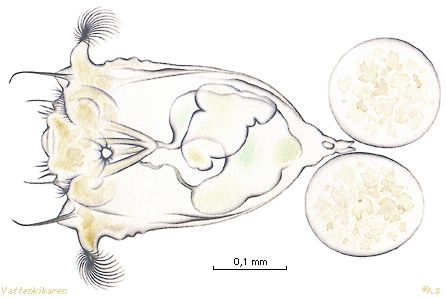 |
 |

 Distribtution in scandinavian waters |
Maximum diametre: approx. 0,45 mm. Compare
with the size of a hair. Appearance: A crown of cilia on the forefront build a sort of paddle organ, which has recieved its name because of the cilia´s quick movements that make it resemble a rotating paddle wheel. The body is quite transparent, but darker, often violet internal structures can be decerned. The synchaeta-rotifer can be easily recognized because of the stiff brush at the fore end and the presence of two cilia furnished outgrowths on the side. The back of the body has an outgrowth known as the foot. In the picture above, two eggs are attached to the foot. Depth: From the surface to unknown depth. Environment: Pelagic and found in rock pools . Misc: Rotifers of the synchaeta family swim and collect food with the help of a paddle organ. They eat small organisms and other particles that are found in the water. They themselves often fall prey to larger creatures, such as fish. Like the water-flea, the eggs can develope without being fertilized. Most rotifers are found in freshwater, but a large number of specie tolerate brackish water. A small number of specie are purely Marine. Many rotifers are pelagic, but there are specie that attach themselves to the bottom or onto other organisms. Classification: Synchaeta-rotifers are members of the rotifer group. |